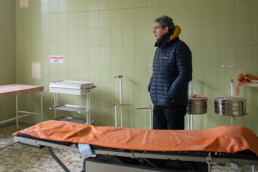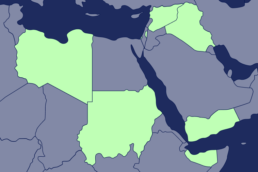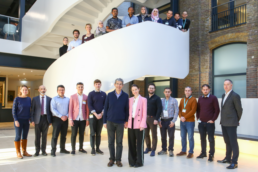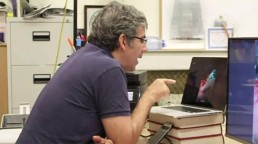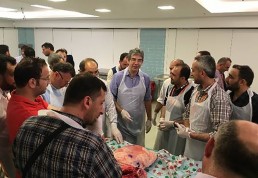BBC Newsnight: The doctors ‘breaking the siege’ in Aleppo via Skype
The battle over Aleppo has been raging for more than five years – with the Syria city under siege for much of this time.
The medical and humanitarian situation is desperate.
Two years ago, British doctor David Nott got into Aleppo to help train doctors there. Now he’s helping to get round the siege by directing life-saving operations via Skype. He spoke to BBC Newsnight.
Watch the full report here.
BBC Radio 4: ‘Aleppo doctors facing armageddon’
A British volunteer is worried for his colleagues as two hospitals in Aleppo, Syria, were hit during an aerial bombardment and are vulnerable to further attacks.
David Nott is a British surgeon and has worked in the hospitals and trained some of the doctors who treat people with the terrible injuries inflicted by these bombs.
He told World At One reporter Becky Milligan of his concerns for the doctors still working there and how he feels like a father to many.
More here.
David Nott Foundation concludes first surgical training course in Turkey
The first David Nott Foundation Hostile Environment Surgical Training (HEST®) course concluded in Gaziantep, Turkey on 17 April, 2016. The HEST® course is a satellite of the Surgical Training for the Austere Environment (STAE) course which David directs at the Royal College of Surgeons of England. The HEST® course has a smaller faculty and fewer resource needs meaning it can take surgical training right to the front line.
Eight faculty members, including Course Director David Nott, taught 30 Syrian doctors life-saving surgical techniques. They were taught neurosurgery, maxillo-facial, thoracic, cardiac, abdominal, vascular and paediatric surgery, orthopaedics and obstetrics and gynaecology.
The Syrian doctors travelled from Hama, Homs, Idlib and Aleppo to be taught by David and his faculty. Many of the surgeons David had worked with before, during his visits to Syria in 2012, 2013 and 2014.
‘It was wonderful to see so many familiar faces and continue the teaching I have been honoured to be able to give over many years to my Syrian friends. By holding this course on the Turkish-Syrian border we are bringing life-saving surgical techniques directly to the people who need them most. Following the fantastic response to this inaugural course, we will in the future hold more HEST® courses wherever in the world there is the need,’ David said.

David with the HEST® faculty and students
The Telegraph: ‘They looked like they were coming out of a concentration camp’
By Raf Sanchez, Middle East Correspondent
For fifteen hours a day, the flow of wounded men, women and children from the remains of Syria’s largest city did not stop. Aleppo residents – evacuated to the safety of the countryside after a six-month siege – came with bones jutting through their skin, limbs succumbing to gangrene and shrapnel still buried in their wounds.
“They looked almost like they were coming out of a concentration camp,” said David Nott, a British surgeon who returned to Britain last week after spending eight days in Syria’s Idlib province treating the injured.
Dr Nott works in operating theatres across three London hospitals but has made repeated medical trips into Syria since fighting started in 2011. He trained many of the doctors who worked in east Aleppo’s makeshift hospitals throughout the regime siege and Russian bombardment and wanted to be there to help when 30,000 civilians and fighters finally left the city in early December under the terms of a ceasefire deal.
Over the course of a frenetic week of surgery, he operated on 90 people, including 30 children. “The patients were really in desperate state” after months with little food and harrowing journey out of the city through snow and freezing temperatures, Dr Nott said.
“They were coming in not just injured but dehydrated, malnourished, and psychologically traumatised.” Doctors in Aleppo focused on saving “lives not limbs” and performed hundreds of rapid amputations with only valium and ketamine to offer their patients for the pain. With no way of sterilising the wounds, the injuries became infected and Dr Nott and his colleagues were sometimes forced to amputate a second time in order to keep people alive.
Read more here.
David Nott: Working in Aleppo
When Abdel Malek was brought into the emergency room in Aleppo in September 2014, his lower left leg was so badly damaged by fragments from a barrel bomb attack that the Syrian doctors thought they would have to amputate the little boy’s foot.
The doctors that remain in Aleppo are passionate and committed but did not have specialist training in vascular, orthopaedic, plastic or reconstructive surgery, understandably given how the war has halted their education and training. I took over the management of the case and was able to show them another way of treating the little boy which would also save his foot.
We took the tiny long saphenous vein from Abdel Malek’s right leg and did a bypass graft to the injured lower leg and foot. The next stage was a cross leg flap to cover the bypass graft. Abdel Malek was kept in this position for three weeks, with his foot elevated and held in place with external fixators, to allow the flap to get its blood supply from the injured leg.
The flap was cut a month later and the legs separated. With the continuing care of the surgeons I trained, Abdel Malek’s foot healed and slowly and steadily, he started to walk again. I was overjoyed when my friends in Aleppo sent me a video on WhatsApp of Abdel Malek playing football with his friends. It demonstrated to me the power of surgery and the options it presents for reconstruction and recovery.
Moments like this were sadly very rare when I was in Syria in September – October 2014. Indiscriminate bombing of civilian areas with grossly destructive barrel bombs – crude devices filled with TNT and shrapnel – caused the most injuries. Day after day, the emergency room and operating theatre were filled with innocent people blown to pieces by these crude devices. Often all we could do was try to ease their pain.
Read the complete blog at: The Hippocratic Post
